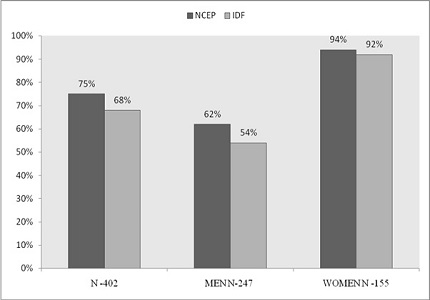Diverse criteria’s-disparate prevalence rates: prevalence of metabolic syndrome by modified NCEP-ATP III and IDF criteria
Abstract
Background: Metabolic syndrome is a cluster of metabolic risk factors including central obesity, glucose intolerance, atherogenic dyslipidemia and hypertension. Studies have shown a prevalence of 10 - 84% in general population and 57- 92% in type 2 diabetic patients.
Aims and Objectives: Our study aims to establish the prevalence of metabolic syndrome in diabetic patients at Karnataka Institute of Diabetology, Bangalore. It aims to compare the prevalence using modified NCEP-ATP III and IDF criteria, and also in women and men.
Methodology: A cross-sectional study was conducted in 402 (38.6% women, 61.4% men) type 2 diabetic subjects. Fasting blood glucose, lipid profile, waist circumference and blood pressure were recorded. Modified NCEP-ATP III and IDF criteria were used to calculate the prevalence of metabolic syndrome.
Results: The prevalence of metabolic syndrome was 75.1% by modified NCEP-ATP III and 68% by IDF criteria. The prevalence was 94% and 92% in women and 62% and 54% in men, by modified NCEP-ATP III and IDF criteria respectively. Hypertension was the commonest component in men, and high waist circumference was the commonest component in women. Nearly 50% had 4 components of metabolic syndrome, ≈30% had 3 components and ≈25% had all the 5 components.
Conclusions: The prevalence of metabolic syndrome is very high among diabetic patients. It is higher using modified NCEP-ATP III compared to IDF criteria, especially in men. The prevalence is higher in women, due to central obesity. Hence, all type 2 diabetic patients must be evaluated for metabolic syndrome.
Downloads
References
2. Reaven GM. Role of Insulin Resistance in Human Disease Diabetes Dec. 1988; 37 (12): 1595-1607. doi: 10.2337/diab.37.12.1595. [PubMed]
3. Eckel RH, Grundy SM, Zimmet PZ. The metabolic syndrome. The Lancet. 2005 Apr 22; 365(9468):1415-28. http://dx.doi.org/10.1016/S0140-6736(05)66378-7. [PubMed]
4. Isomaa BO, Almgren P, Tuomi T, Forsén B, Lahti K, Nissén M, Taskinen MR, Groop L. Cardiovascular morbidity and mortality associated with the metabolic syndrome. Diabetes Care 2001 Apr; 24(4): 683-689. http://dx.doi.org/10.2337/diacare.24.4.683.
5. Stern MP, Williams K, González-Villalpando C, Hunt KJ, Haffner SM. Does the metabolic syndrome improve identification of individuals at risk of type 2 diabetes and/or cardiovascular disease? Diabetes Care 2004 Nov; 27(11): 2676-2681. http://dx.doi.org/10.2337/diacare.27.11.2676.
6. Huang PL. A comprehensive definition for metabolic syndrome. Disease Models & Mechanisms. 2009; 2(5-6):231-237. doi:10.1242/dmm.001180. [PubMed]
7. Kaur J. A Comprehensive Review on Metabolic Syndrome. Cardiology Research and Practice. 2014; 2014:943162. doi:10.1155/2014/943162. [PubMed]
8. International Diabetes Federation: The IDF consensus worldwide definition of the metabolic syndrome. http://www.idf.org/metabolic-syndrome.
9. Ford ES, Giles WH, Dietz WH. Prevalence of the Metabolic Syndrome Among US Adults: Findings From the Third National Health and Nutrition Examination Survey. JAMA.2002; 287(3):356-359. doi:10.1001/jama.287.3.356.
10. Mohan V, Shanthirani S, Deepa R, Premalatha G, Sastry NG, Saroja R. Intra-urban differences in the prevalence of the metabolic syndrome in southern India – the Chennai Urban Population Study (CUPS No. 4). Diabetic Medicine, 2001; 18: 280–287. doi:10.1046/j.1464-5491.2001.00421.x [PubMed]
11. Kanjilal S, Shanker J, Rao VS, et al. Prevalence and component analysis of metabolic syndrome: An Indian atherosclerosis research study perspective. Vascular Health and Risk Management. 2008; 4(1):189-197.
12. Kempegowda P, Marcus SR, Solanki P et al. Prevalence of the metabolic syndrome in rural India- a disparity in definitions. Int J Diabetes Dev Ctries (2011) 31: 188. doi:10.1007/s13410-011-0046-y.
13. Alebiosu CO, Odusan BO. Metabolic syndrome in subjects with type-2 diabetes mellitus. Journal of the National Medical Association. 2004; 96(6):817-821. [PubMed]
14. Alexander CM, Landsman PB, Teutsch SM, Haffner SM. NCEP-defined metabolic syndrome, diabetes, and prevalence of coronary heart disease among NHANES III participants age 50 years and older. Diabetes. 2003 May; 52(5): 1210-1214. http://dx.doi.org/10.2337/diabetes.52.5.1210.
15. Janghorbani M, Amini M. Metabolic syndrome in type 2 diabetes mellitus in Isfahan, Iran: prevalence and risk factors. Metab Syndr Relat Disord. 2007 Sep; 5(3):243-54. doi: 10.1089/met.2005.0010. [PubMed]
16. Kengne AP, Limen SN, Sobngwi E, Djouogo CF, Nouedoui C. Metabolic syndrome in type 2 diabetes: comparative prevalence according to two sets of diagnostic criteria in sub-Saharan Africans. Diabetology & Metabolic Syndrome. 2012; 4:22. doi: 10.1186/1758-5996-4-22.
17. Yadav D, Mahajan S, Subramanian SK, Bisen PS, Chung CH, Prasad G. Prevalence of Metabolic Syndrome in Type 2 Diabetes Mellitus Using NCEP-ATPIII, IDF and WHO Definition and Its Agreement in Gwalior Chambal Region of Central India. Global Journal of Health Science. 2013; 5(6):142-155. doi:10.5539/gjhs.v5n6p142.
18. Nsiah K, Shang VO, Boateng KA, Mensah F. Prevalence of metabolic syndrome in type 2 diabetes mellitus patients. Int J App Basic Med Res, 2015; 5(2):133-138. [PubMed]
19. Nsiah K, Shang VO, Boateng KA, Mensah F. Prevalence of metabolic syndrome in type 2 diabetes mellitus patients. International Journal of Applied and Basic Medical Research. 2015; 5(2):133-138. doi:10.4103/2229-516X.157170.
20. Cameron AJ, Magliano DJ, Zimmet PZ, Welborn TA, Colagiuri S, Tonkin AM, Shaw JE. The metabolic syndrome as a tool for predicting future diabetes: the AusDiab study. Journal of Internal Medicine, 264: 177–186. doi:10.1111/j.1365-2796.2008.01935.x
21. Hu G, Qiao Q, Tuomilehto J, et al. Prevalence of the Metabolic Syndrome and Its Relation to All-Cause and Cardiovascular Mortality in Nondiabetic European Men and Women. Arch Intern Med. 2004; 164(10):1066-1076. doi:10.1001/archinte.164.10.1066.
22. Hunt KJ, Resendez RG, Williams K, Haffner SM, Stern MP. National Cholesterol Education Program versus World Health Organization metabolic syndrome in relation to all-cause and cardiovascular mortality in the San Antonio Heart Study. Circulation, 2004; 110(10):1251-7. doi: 10.1161/01.CIR.0000140762.04598.F9.



 OAI - Open Archives Initiative
OAI - Open Archives Initiative


